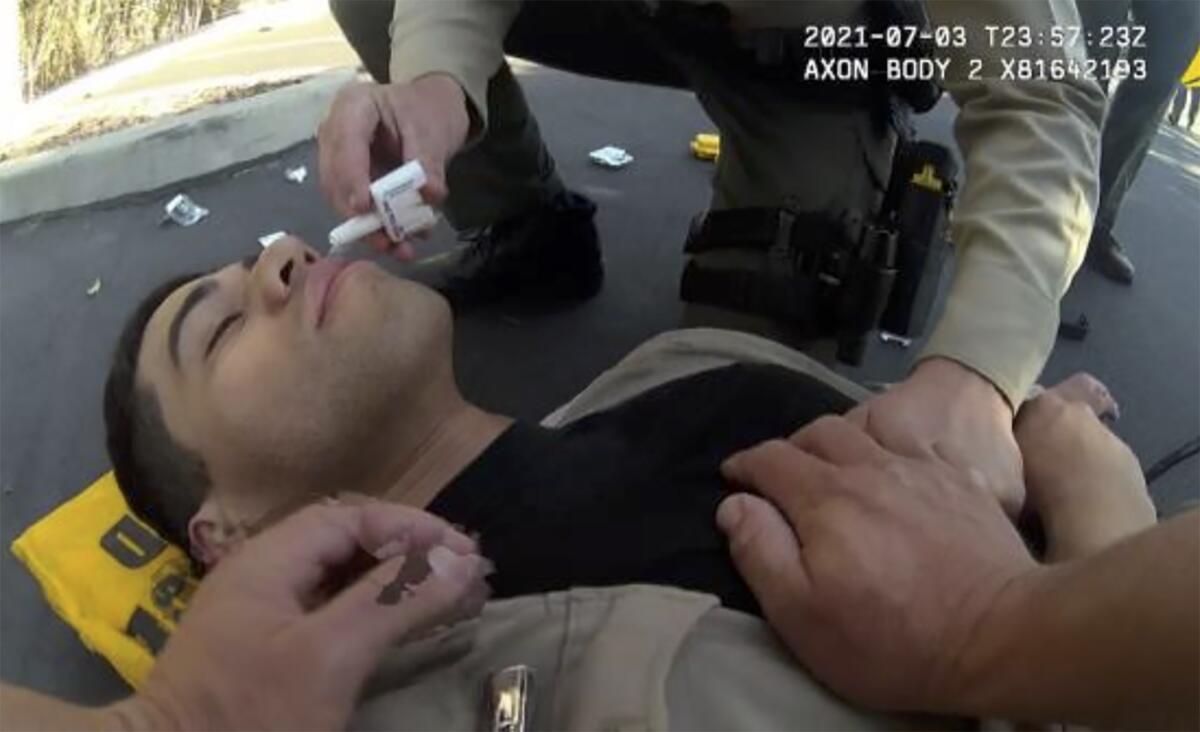Op-Ed: How misinformation about fentanyl can be deadly

Touch fentanyl, and you’ll die. That’s what law enforcement officials want you to believe.
Recently, a dramatic, but inaccurate “public safety” video was released by the San Diego County’s Sheriff Department. And it went viral. The video purported to show a deputy overdosing on fentanyl from brief contact with a white powder at the scene of an arrest.
The reality is you can’t overdose from fentanyl in this way. After criticism of the video, San Diego County Sheriff Bill Gore admitted he, not a doctor, diagnosed the incident as an overdose; and no toxicology reports were performed.
Yet, the damage was done.
The video was quickly picked up by media outlets around the country, without interviewing medical experts who have said that fentanyl cannot be absorbed simply by touching it nor can it be easily aerosolized. The deputy’s reaction on the video could well have another cause, such as a panic or anxiety attack. But when a law enforcement agency puts out this kind of misinformation, it becomes accepted truth. And it could cause first responders to avoid getting close to a person overdosing for fear of contacting fentanyl.
All of this distracts from the tragic reality that fentanyl was involved in more than 60% of overdose deaths last year. In fact, law enforcement crackdowns on opioids have created perverse incentives for underground chemists to increase the potency of their drugs (so they weigh less and are easier to smuggle) and resulted in a more toxic drug supply. People are overdosing after injecting fentanyl, snorting lines of it, or swallowing it, but not simply from handling it.
More broadly, erroneous police statements can create an atmosphere that forces politicians to propose counterproductive policies in the midst of a panic.
We already know how this story goes, because we experienced it in the ’80s and ’90s, with narratives about crack cocaine being used to create policies that shattered lives, families and communities. Law enforcement-driven, media-perpetuated fear-mongering inevitably leads to extreme racially biased enforcement and mandatory minimum sentencing. President Biden created many of these policies as a senator and he is repeating these harms by extending the Trump-era decision to place fentanyl’s related analogues (compounds with a slightly different chemical structure) on schedule I of the Controlled Substances Act, which includes drugs like heroin. This gives the Department of Justice broad authority to prosecute individuals regardless of whether they knew the drugs contained fentanyl or even a trace amount of a fentanyl-related substance.
It’s been 50 years since Nixon declared the “war on drugs” and tried to convince Americans that criminalization would end drug use and save lives. Yet, overdose deaths are skyrocketing. They increased by 52% in Los Angeles County during the first 10 months of the pandemic compared with 2019 and claimed the lives of more than 94,000 people across the U.S. last year, up from 47,000 in 2014.
And it’s not just the overdosing that is destroying lives and communities — there are more people in our jails and prisons with drug or mental health problems than in treatment, and they are disproportionately low-income and from communities of color. Drug charges remain the No. 1 cause of arrest in this country, with stark racial disparities that systematically harm generations of families in every aspect of life. Incarceration itself is linked with increased mortality from overdose, with individuals almost 13 times more likely to die from overdose than the general population within the first two weeks of release. If we truly want to save lives, we need to move toward comprehensive drug decriminalization and remove drugs from the domain of law enforcement.
Overdose is preventable with a public health response, not a criminal one. We need to focus on and fund real solutions that work, like access to life-saving naloxone, harm reduction services, evidence-based treatments including medications like methadone and buprenorphine, overdose prevention centers, and access to drug checking equipment.
The San Diego County sheriff needs to do the right thing and retract the video. And it’s time for the federal government to divest from our reliance on policing and punishment-first strategies that have failed to save lives or reduce the supply of fentanyl-related substances. Our communities would be made safer with health- and evidence-based approaches — like the S.T.O.P. Fentanyl Act, now before the Senate — that address the root cause of fentanyl-related overdoses.
It’s misinformation, not touching fentanyl, that kills.
Sheila Vakharia is deputy director of research and academic engagement at the Drug Policy Alliance. Jeannette Zanipatin is California state director for the organization.
More to Read
A cure for the common opinion
Get thought-provoking perspectives with our weekly newsletter.
You may occasionally receive promotional content from the Los Angeles Times.










